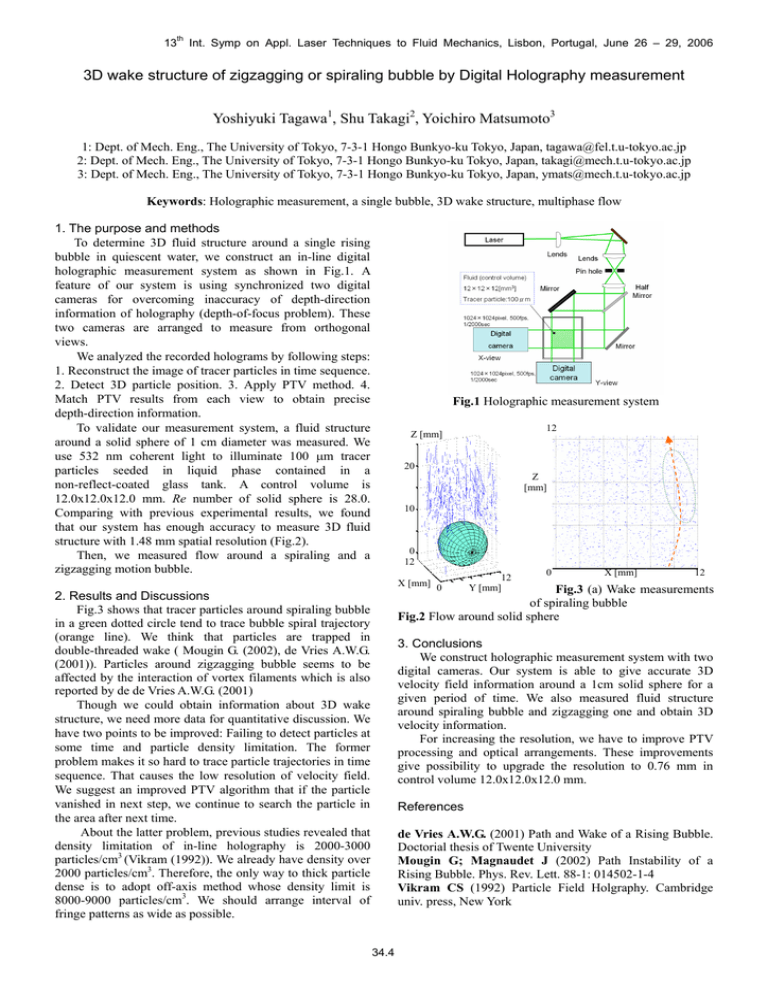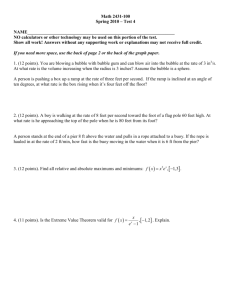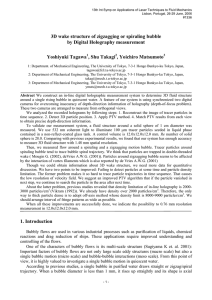3D wake structure of zigzagging or spiraling bubble by Digital... Yoshiyuki Tagawa
advertisement

13th Int. Symp on Appl. Laser Techniques to Fluid Mechanics, Lisbon, Portugal, June 26 – 29, 2006 3D wake structure of zigzagging or spiraling bubble by Digital Holography measurement Yoshiyuki Tagawa1, Shu Takagi2, Yoichiro Matsumoto3 1: Dept. of Mech. Eng., The University of Tokyo, 7-3-1 Hongo Bunkyo-ku Tokyo, Japan, tagawa@fel.t.u-tokyo.ac.jp 2: Dept. of Mech. Eng., The University of Tokyo, 7-3-1 Hongo Bunkyo-ku Tokyo, Japan, takagi@mech.t.u-tokyo.ac.jp 3: Dept. of Mech. Eng., The University of Tokyo, 7-3-1 Hongo Bunkyo-ku Tokyo, Japan, ymats@mech.t.u-tokyo.ac.jp Keywords: Holographic measurement, a single bubble, 3D wake structure, multiphase flow 1. The purpose and methods To determine 3D fluid structure around a single rising bubble in quiescent water, we construct an in-line digital holographic measurement system as shown in Fig.1. A feature of our system is using synchronized two digital cameras for overcoming inaccuracy of depth-direction information of holography (depth-of-focus problem). These two cameras are arranged to measure from orthogonal views. We analyzed the recorded holograms by following steps: 1. Reconstruct the image of tracer particles in time sequence. 2. Detect 3D particle position. 3. Apply PTV method. 4. Match PTV results from each view to obtain precise depth-direction information. To validate our measurement system, a fluid structure around a solid sphere of 1 cm diameter was measured. We use 532 nm coherent light to illuminate 100 µm tracer particles seeded in liquid phase contained in a non-reflect-coated glass tank. A control volume is 12.0x12.0x12.0 mm. Re number of solid sphere is 28.0. Comparing with previous experimental results, we found that our system has enough accuracy to measure 3D fluid structure with 1.48 mm spatial resolution (Fig.2). Then, we measured flow around a spiraling and a zigzagging motion bubble. Fig.1 Holographic measurement system 12 Z [mm] 20 Z [mm] 10 0 12 X [mm] 0 12 Y [mm] 0 X [mm] 12 Fig.3 (a) Wake measurements of spiraling bubble Fig.2 Flow around solid sphere 2. Results and Discussions Fig.3 shows that tracer particles around spiraling bubble in a green dotted circle tend to trace bubble spiral trajectory (orange line). We think that particles are trapped in double-threaded wake ( Mougin G. (2002), de Vries A.W.G. (2001)). Particles around zigzagging bubble seems to be affected by the interaction of vortex filaments which is also reported by de de Vries A.W.G. (2001) Though we could obtain information about 3D wake structure, we need more data for quantitative discussion. We have two points to be improved: Failing to detect particles at some time and particle density limitation. The former problem makes it so hard to trace particle trajectories in time sequence. That causes the low resolution of velocity field. We suggest an improved PTV algorithm that if the particle vanished in next step, we continue to search the particle in the area after next time. About the latter problem, previous studies revealed that density limitation of in-line holography is 2000-3000 particles/cm3 (Vikram (1992)). We already have density over 2000 particles/cm3. Therefore, the only way to thick particle dense is to adopt off-axis method whose density limit is 8000-9000 particles/cm3. We should arrange interval of fringe patterns as wide as possible. 3. Conclusions We construct holographic measurement system with two digital cameras. Our system is able to give accurate 3D velocity field information around a 1cm solid sphere for a given period of time. We also measured fluid structure around spiraling bubble and zigzagging one and obtain 3D velocity information. For increasing the resolution, we have to improve PTV processing and optical arrangements. These improvements give possibility to upgrade the resolution to 0.76 mm in control volume 12.0x12.0x12.0 mm. References de Vries A.W.G. (2001) Path and Wake of a Rising Bubble. Doctorial thesis of Twente University Mougin G; Magnaudet J (2002) Path Instability of a Rising Bubble. Phys. Rev. Lett. 88-1: 014502-1-4 Vikram CS (1992) Particle Field Holgraphy. Cambridge univ. press, New York 34.4





